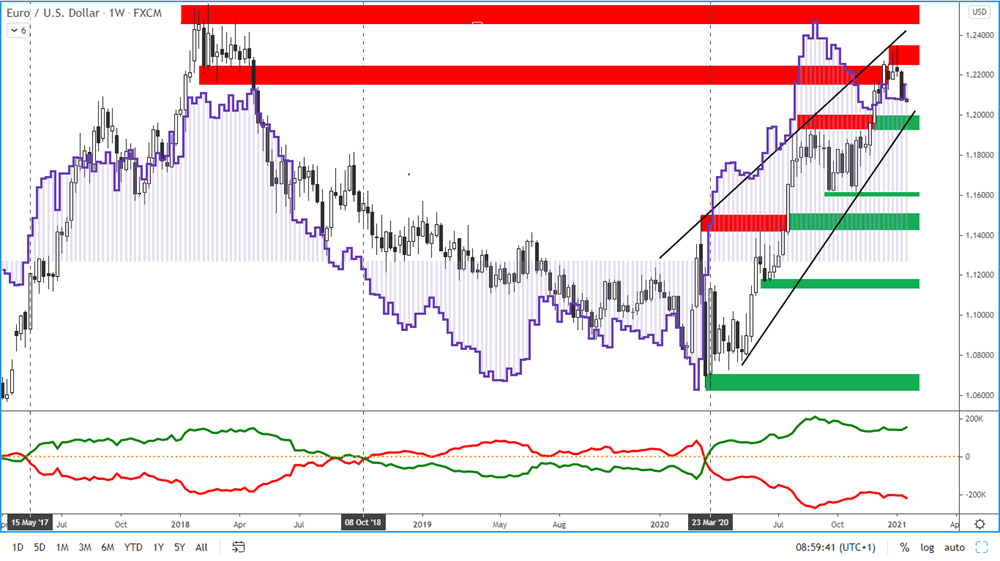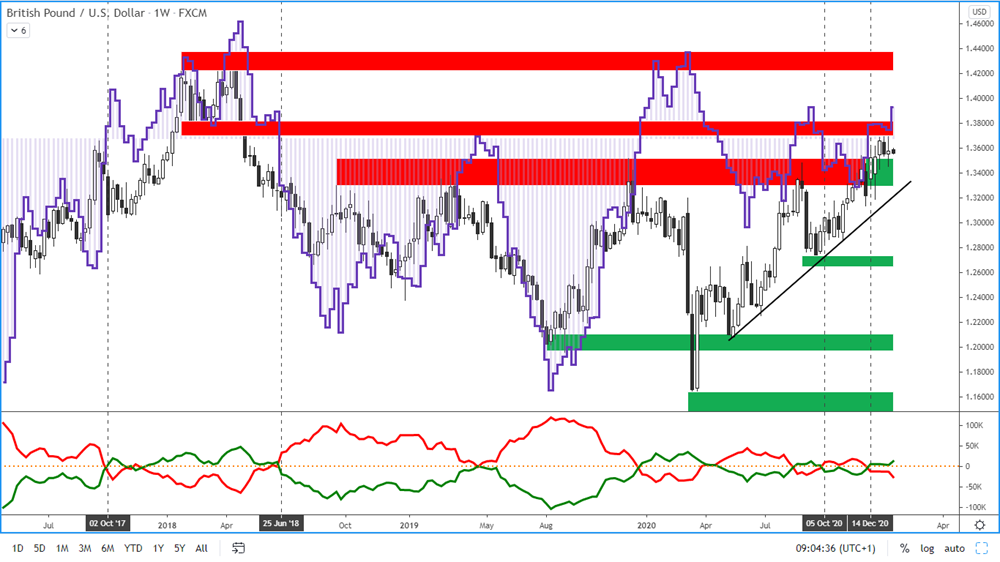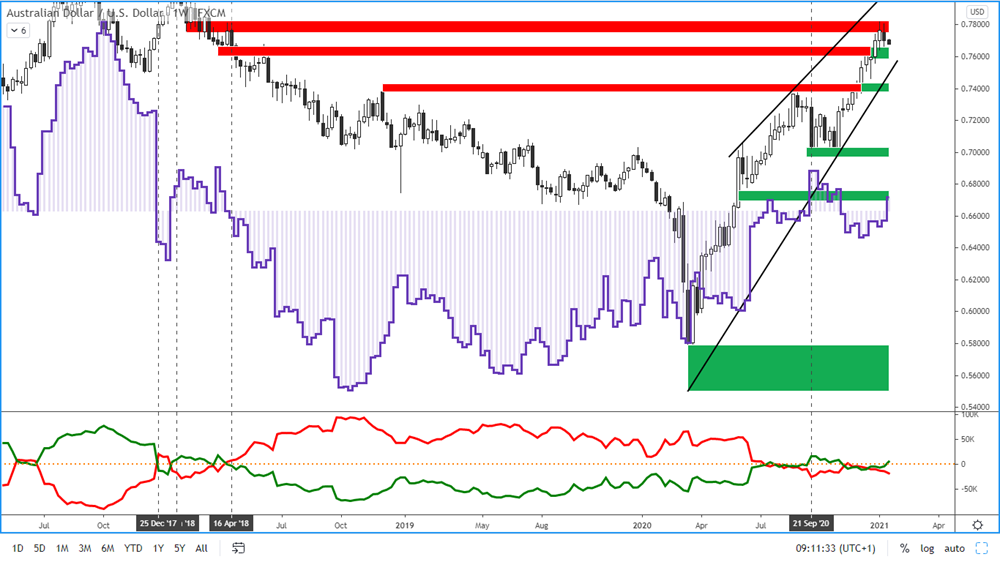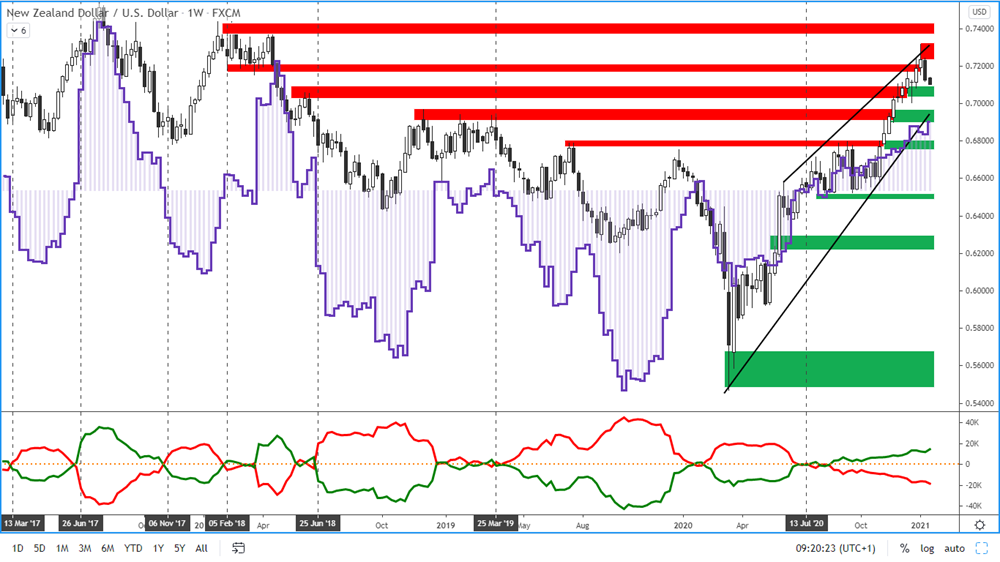Positions of large speculators according to the COT report as at 15/1/2021
Total net positions in the USD index rose by 1,100 contracts last week. This change is the result of a decrease in net long positions by 900 and a decrease in net short positions by 2000 contracts. The total net positions in the USD index have been negative for ten weeks in a row.
The decline in total net positions occurred only in the Canadian dollar. In other currencies, speculators increased their total net positions. A sequence of 10 weeks in a row of negative total net positions in the Australian dollar ended.
Based on that it looks like big speculators seem to believe in riskier currencies, suggesting that the economy should continue to recover. According to speculators, the US dollar should remain under pressure. The current strengthening of the dollar may be a short-term correction in this respect.
The positions of speculators in individual currencies
|
|
15/1/2021
|
8/1/2021
|
4/1/2021
|
28/12/2020
|
18/12/2020
|
11/12/2020
|
|
USD index
|
-13 900
|
-15 000
|
-14 600
|
-14 900
|
-14 100
|
-6 500
|
|
EUR
|
155 900
|
143 000
|
143 100
|
143 900
|
141 800
|
156 400
|
|
GBP
|
12 900
|
3 700
|
4 800
|
6 000
|
4 100
|
5 700
|
|
AUD
|
5 500
|
- 3 900
|
-6 500
|
- 4 400
|
-9 300
|
-10 100
|
|
NZD
|
14 700
|
12 000
|
12 500
|
13 700
|
14 200
|
10 600
|
|
CAD
|
12 100
|
14 500
|
15 400
|
10 100
|
-15 700
|
-20 800
|
|
CHF
|
12 000
|
9 400
|
11 800
|
12 200
|
9 300
|
10 400
|
|
JPY
|
50 500
|
50 200
|
47 300
|
46 100
|
44 000
|
48 200
|
Table 1: Total net positions of large speculators
Notes:
Large speculators are traders who trade large volumes of futures contracts, which, if the required limits are met, must be reported to the Commodity Futures Trading Commission. Typically, this includes traders such as funds or large banks. These traders mostly focus on trading of long-term trends.
Total net positions are the difference between the number of bullish long contracts and the number of bearish short contracts. The data is published every Friday and is delayed because it shows the status on Tuesday of the week.
The sentiment of large speculators will allow you to see what position this group occupies in the market. It is important to monitor the overall trend of total net positions, but also separately the trend of bearish short positions and the trend of bullish long positions. Extreme values of total net positions are also important as they often serve as signals of a trend reversal.
It is also important to monitor the turning points, when the total net positions change from bullish sentiment to bearish and vice versa. These inflection points are indicated in the graphs in section 3.
The chart compares the current value of the total net positions of large speculators with the value 3 years ago. A score of 0% means that speculators are at their lowest levels in 3 years. A score of 100% means that speculators are at the highest values in the last 3 years. A value of 80% or more means that speculators are extremely bullish, and a value of 20% or less means that speculators are extremely bearish.
Detailed analysis of selected currencies
Explanations:
-
Purple line and histogram in the chart window: this is information on the overall net position of large speculators.
-
Green linein the indicator window: these are the bullish positions of large speculators.
-
Red line in the indicator window: indicates the bearish positions of large speculators.
If there is a green line above the red line in the indicator window, then it means that the overall net positions are positive, i.e. that bullish sentiment prevails. If, on the other hand, the green line is below the red line, then bearish sentiment prevails and the overall net positions of the big speculators are negative.
Charts are made with the use of www.tradingview.com.
Euro
|
Weekly change in total net positions
|
Weekly change in total long positions
|
Weekly change in total short positions
|
Sentiment
|
|
+ 12 900
|
3 900
|
- 9 000
|
bullish
|

Figure1: The euro and COT positions of large speculators on a weekly chart
Total net positions rose by 12,900 contracts last week. This change is the result of an increase in net long positions by 3,900 contracts and a decrease in net short positions by 9,000 contracts.
The price of the euro fell sharply last week and is approaching the first significant support.
Long-term resistance: 1.2250 - 1.2340
Long-term support: 1.1950 - 1.2000
The British Pound
|
Weekly change in total net positions
|
Weekly change in total long positions
|
Weekly change in total short positions
|
Sentiment
|
|
9 200
|
12 400
|
3 200
|
bullish
|

Figure 2: The GBP and COT positions of large speculators on a weekly chart
Last week, total net positions rose by 9,200 contracts. This change is the result of an increase in net long positions by 12,400 contracts, while net short positions grew by 3,200 contracts.
The pound sterling opened and closed last week at about the same price signaling indecisiveness. It is therefore possible that there may be some correction of the current upward trend.
Long-term resistance: 1.37-1.3820
Long-term support: 1.33-1.3500
The Australlian Dollar
|
Weekly change in total net positions
|
Weekly change in total long positions
|
Weekly change in total short positions
|
Sentiment
|
|
9 400
|
700
|
- 8 700
|
bullish
|

Figure 3: The AUD and COT positions of large speculators on a weekly chart
Total net positions are in the Australian dollar for the first time in 10 weeks in bullish sentiment. Last week, total net positions grew by 9,400 contracts. This change is the result of an increase in net long positions by 700 contracts, while net short positions decreased by 8,700 contracts.
The Australian dollar is in an upward trend on the weekly chart, however, a correction was made last week and the Australian weakened by about 50 pips.
Long-term resistance: 0.7750-0.7820
Long-term support: 0.7600-0.7650
The New Zealand Dollar
|
Weekly change in total net positions
|
Weekly change in total long positions
|
Weekly change in total short positions
|
Sentiment
|
|
+ 2 700
|
- 400
|
- 3 100
|
bullish
|

Figure 4: The NZD and the position of large speculators on a weekly chart
In the New Zealand dollar, total net positions are still in bullish sentiment, which has been going on for 22 consecutive weeks. Last week, total net positions grew by 2,700 contracts. This change is the result of a decrease in net long contracts by 400 and a decrease in net short contracts by 3,100 contracts.
The price of the NZDUSD weakened significantly by about 100 pips last week and is approaching the first major support.
Resistance: 0.7230-0.7320
The nearest support: 0.7050-0.7100